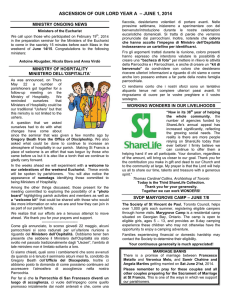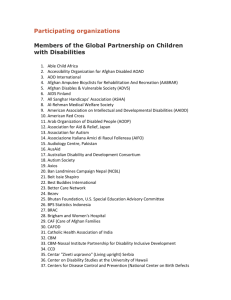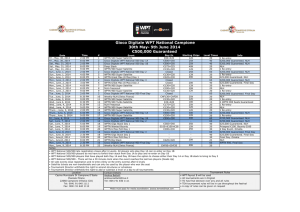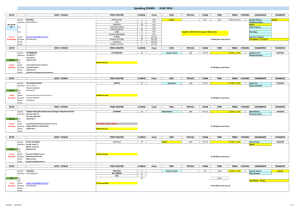People with a learning disability in Sheffield
advertisement
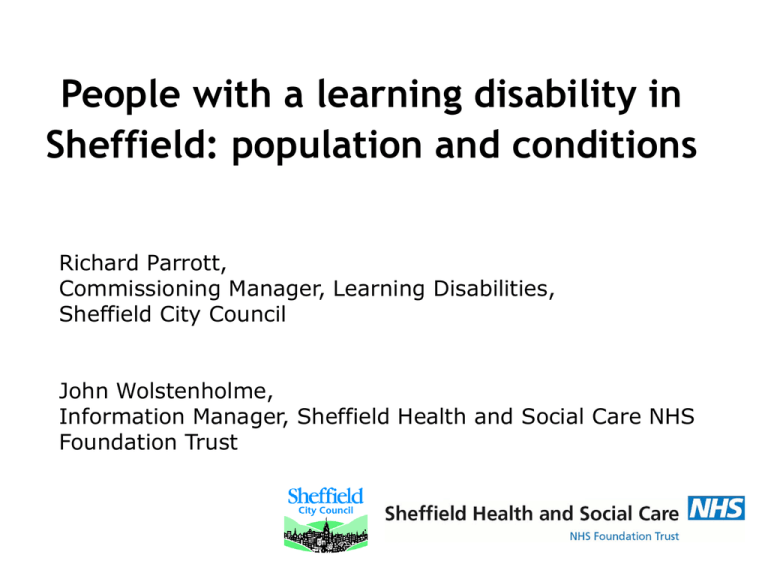
People with a learning disability in Sheffield: population and conditions Richard Parrott, Commissioning Manager, Learning Disabilities, Sheffield City Council John Wolstenholme, Information Manager, Sheffield Health and Social Care NHS Foundation Trust Strength of the current evidence? Valuing People Now (2007) • Data about the increasing demands on learning disability services is not as well researched as for other service areas • Valuing People Support Team to develop a better understanding to inform spending decisions in the next Comprehensive Spending Review… • … meanwhile, local commissioners expected to develop accurate information on numbers and future changes Sheffield Case Register Any person satisfying one or more of the following criteria should be included on the Register: • People who are assessed as having a severe learning disability and needing a developmental curriculum. • Has used or is using a learning disability service on a regular basis. • Has a clinical condition which is a recognised cause of learning disability. • Has a diagnosis of “Mental Retardation” other than “Mild Mental Retardation”. • Requires or is expected to require support from residential, day or community services by reason of learning disability. Fig. 1: Numbers of people with a learning disability in Sheffield, 1998 to 2008 (Sheffield Case Register June 2008) 400 Number of people 350 300 June 08 250 June 03 June 98 200 150 100 50 0 1014 1519 2024 2529 3034 3539 4044 4549 5054 5559 6064 6569 7074 7579 8084 85+ Age group Between 1998 and 2008… the total number of people with a learning disability increased 25% from 2465 to 3080 Fig. 1: Numbers of people with a learning disability in Sheffield, 1998 to 2008 (Sheffield Case Register June 2008) 400 Number of people 350 300 June 08 250 June 03 June 98 200 150 100 50 0 1014 1519 2024 2529 3034 3539 4044 4549 5054 5559 6064 6569 7074 7579 8084 85+ Age group Between 1998 and 2008… the number of 10 to 20 year olds with a learning disability increased by 120% from 313 to 699 Fig. 1: Numbers of people with a learning disability in Sheffield, 1998 to 2008 (Sheffield Case Register June 2008) 400 Number of people 350 300 June 08 250 June 03 June 98 200 150 100 50 0 1014 1519 2024 2529 3034 3539 4044 4549 5054 5559 6064 6569 7074 7579 8084 85+ Age group Between 1998 and 2008… the number of over 65s with a learning disability increased by 25% from 180 to 225 Fig. 1: Numbers of people with a learning disability in Sheffield, 1998 to 2008 (Sheffield Case Register June 2008) 400 Number of people 350 300 June 08 250 June 03 June 98 200 150 100 50 0 1014 1519 2024 2529 3034 3539 4044 4549 5054 5559 6064 6569 7074 7579 8084 85+ Age group Between 1998 and 2008… the number of people with a learning disability from BME communities increased by 80% from 187 to 339 Fig. 1: Numbers of people with a learning disability in Sheffield, 1998 to 2008 (Sheffield Case Register June 2008) 400 Number of people 350 300 June 08 250 June 03 June 98 200 150 100 50 0 1014 1519 2024 2529 3034 3539 4044 4549 5054 5559 6064 6569 7074 Age group Between 2003 and 2008… the number of 10 to 14 year olds increased 38% from 507 to 699 7579 8084 85+ Fig. 1: Numbers of people with a learning disability in Sheffield, 1998 to 2008 (Sheffield Case Register June 2008) 400 Number of people 350 300 June 08 250 June 03 June 98 200 150 100 50 0 1014 1519 2024 2529 3034 3539 4044 4549 5054 5559 6064 6569 7074 7579 8084 Age group Between 2003 and 2008… the number of adults (over 20) increased by nearly 10% from 1954 to 2126 85+ People with complex needs Definition of ‘severe or complex needs’ based on Case Register ‘Social and Physical Incapacity Ratings’ 1. Non-ambulant 2. At least partly mobile with severe incontinence and severe behaviour problems 3. Severe behaviour problem 4. Severe incontinence Severe or complex needs 5. No severe problems but only partly mobile 6. Ambulant but mild behaviour and incontinence problems 7. Mild behaviour problem only 8. Mild incontinence problem only 9. Not incapacitated Moderate Low 160 Fig 2: Numbers of people with a severe/complex learning disability in Sheffield, 1998 to 2008. (Sheffield Case Register June 2008) Number of people 140 June 08 June 03 June 98 120 100 80 60 40 20 0 1519 2024 2529 3034 3539 4044 4549 5054 5559 6064 6569 7074 7579 8084 85+ Age group Between 1998 and 2008… • the overall number of people with severe or complex needs rose by 17% from 682 to 786 • the number of 15 to 19 year olds with severe or complex needs increased by 70% from 85 to 144 People with a learning disability - selected diagnoses by age 400 350 G40 Epilepsy F84 Pervasive developmental disorders Number of people 300 Q90 Down's syndrome G80 Infantile cerebral palsy 250 G82 Paraplegia and tetraplegia 200 150 100 50 0 0-9 10-19 20-29 30-39 40-49 Age group 50-59 60-69 70-79 80-89 Sp ee ch A st hm a Ep de il e ve ps lo pm y en ta ld is or de r di st ur ba nc C e on du ct di so rd er D s ow n' s sy nd In ro fa nt m e ile ce re br B lin al pa dn ls es y s an d lo w vi si O on th er he ar in g lo ss O th er de rm at iti s Pe rv as iv e Number of people People with a learning disability: top 10 specific additional conditions 800 700 600 500 400 300 200 100 0 Future demand • 27% increase in adults over 20 with a learning disability from 2020 in 2007, to 2575 in 2017 (based on age specific mortality data, 2007) • 400 people in Sheffield live with family carers over the age of 65 • Increase in learning disabled people from BME communities • Changing expectations • Increase in level and complexity of people’s needs • Increase in number of people with ‘profound and multiple learning disability’ (PMLD) Further information “Changes in demography and demand for services for people with complex needs and profound and multiple learning disabilities” Richard Parrott, John Wolstenholme and Nigel Tilley. Tizard Learning Disability Review, Volume 13, Issue 3, 2008 Richard.Parrott@sheffield.gov.uk John.Wolstenholme@SCT.NHS.UK

